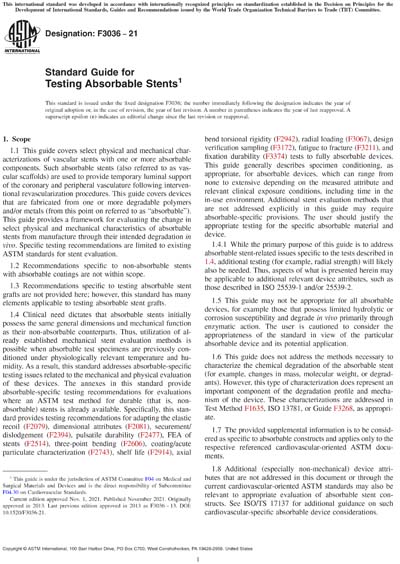Most recent
ASTM F3036-21
Standard Guide for Testing Absorbable Stents
1.1This guide covers select physical and mechanical characterizations of vascular stents with one or more absorbable components. Such absorbable stents (also referred to as vascular scaffolds) are used to provide temporary luminal support of the coronary and peripheral vasculature following interventional revascularization procedures. This guide covers devices that are fabricated from one or more degradable polymers and/or metals (from this point on referred to as "absorbable"). This guide provides a framework for evaluating the change in select physical and mechanical characteristics of absorbable stents from manufacture through their intended degradation in vivo. Specific testing recommendations are limited to existing ASTM standards for stent evaluation.
1.2Recommendations specific to non-absorbable stents with absorbable coatings are not within scope.
1.3Recommendations specific to testing absorbable stent grafts are not provided here; however, this standard has many elements applicable to testing absorbable stent grafts.
1.4Clinical need dictates that absorbable stents initially possess the same general dimensions and mechanical function as their non-absorbable counterparts. Thus, utilization of already established mechanical stent evaluation methods is possible when absorbable test specimens are previously conditioned under physiologically relevant temperature and humidity. As a result, this standard addresses absorbable-specific testing issues related to the mechanical and physical evaluation of these devices. The annexes in this standard provide absorbable-specific testing recommendations for evaluations where an ASTM test method for durable (that is, non-absorbable) stents is already available. Specifically, this standard provides testing recommendations for adapting the elastic recoil (F2079), dimensional attributes (F2081), securement/dislodgement (F2394), pulsatile durability (F2477), FEA of stents (F2514), three-point bending (F2606), coating/acute particulate characterization (F2743), shelf life (F2914), axial bend torsional rigidity (F2942), radial loading (F3067), design verification sampling (F3172), fatigue to fracture (F3211), and fixation durability (F3374) tests to fully absorbable devices. This guide generally describes specimen conditioning, as appropriate, for absorbable devices, which can range from none to extensive depending on the measured attribute and relevant clinical exposure conditions, including time in the in-use environment. Additional stent evaluation methods that are not addressed explicitly in this guide may require absorbable-specific provisions. The user should justify the appropriate testing for the specific absorbable material and device.
1.4.1While the primary purpose of this guide is to address absorbable stent-related issues specific to the tests described in 1.4, additional testing (for example, radial strength) will likely also be needed. Thus, aspects of what is presented herein may be applicable to additional relevant device attributes, such as those described in ISO 25539-1 and/or 25539-2.
1.5This guide may not be appropriate for all absorbable devices, for example those that possess limited hydrolytic or corrosion susceptibility and degrade in vivo primarily through enzymatic action. The user is cautioned to consider the appropriateness of the standard in view of the particular absorbable device and its potential application.
1.6This guide does not address the methods necessary to characterize the chemical degradation of the absorbable stent (for example, changes in mass, molecular weight, or degradants). However, this type of characterization does represent an important component of the degradation profile and mechanism of the device. These characterizations are addressed in Test Method F1635, ISO 13781, or Guide F3268, as appropriate.
1.7The provided supplemental information is to be considered as specific to absorbable constructs and applies only to the respective referenced cardiovascular-oriented ASTM documents.
1.8Additional (especially non-mechanical) device attributes that are not addressed in this document or through the current cardiovascular-oriented ASTM standards may also be relevant to appropriate evaluation of absorbable stent constructs. See ISO/TS 17137 for additional guidance on such cardiovascular-specific absorbable device considerations.
1.9The values stated in SI units are to be regarded as standard. No other units of measurement are included in this standard.
1.10This standard does not purport to address all of the safety concerns, if any, associated with its use. It is the responsibility of the user of this standard to establish appropriate safety, health, and environmental practices and determine the applicability of regulatory limitations prior to use.
1.11This international standard was developed in accordance with internationally recognized principles on standardization established in the Decision on Principles for the Development of International Standards, Guides and Recommendations issued by the World Trade Organization Technical Barriers to Trade (TBT) Committee.
Content Provider
ASTM International [astm]






